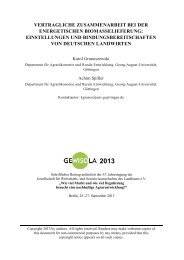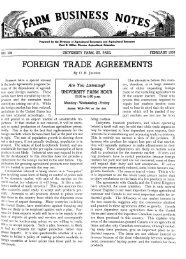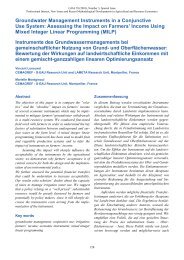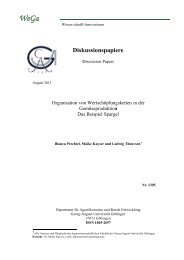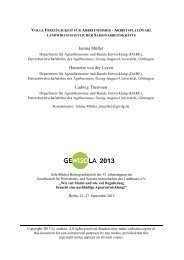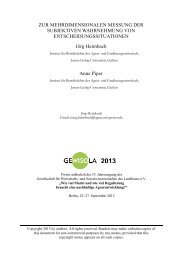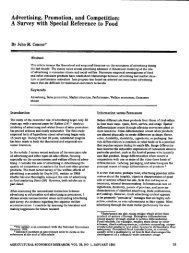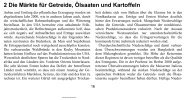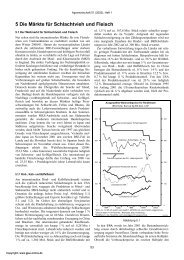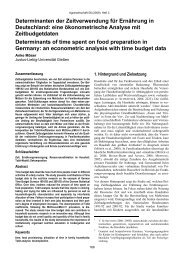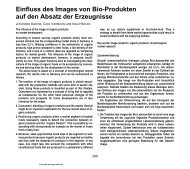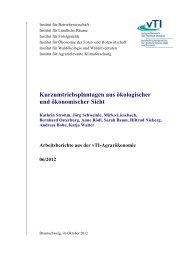RURAL DWELLERS PERCEPTION ON EFFECT ... - AgEcon Search
RURAL DWELLERS PERCEPTION ON EFFECT ... - AgEcon Search
RURAL DWELLERS PERCEPTION ON EFFECT ... - AgEcon Search
Create successful ePaper yourself
Turn your PDF publications into a flip-book with our unique Google optimized e-Paper software.
Journal of Economics and Rural Development Vol. 16, No.1<br />
<strong>RURAL</strong> <strong>DWELLERS</strong> <strong>PERCEPTI<strong>ON</strong></strong> <strong>ON</strong> <strong>EFFECT</strong> OF<br />
INFRASTRUCTURAL FACILITIES <strong>ON</strong> LIVELIHOOD<br />
ACTIVITIES IN AKINYELE LOCAL GOVERNMENT AREA<br />
OF OYO STATE, NIGERIA.<br />
OYESOLA, O.B.<br />
Department of Agric. Extension and Rural Development, University of Ibadan<br />
ob.oyesola@mail.ui.edu.ng; oyetoks2002@yahoo.com<br />
Abstract<br />
Lack of basic infrastructural facilities has been one of the problems of rural poverty<br />
in Nigeria. Various programmes had been introduced by past and present<br />
administrations in Nigeria to provide these facilities in rural area. This study<br />
investigated rural dwellers perception on effect of infrastructural facilities on<br />
Livelihood Activities in Akinyele Local Government Area of Oyo State, Nigeria.<br />
Multi-stage sampling technique was used to selecting one hundred and twenty<br />
respondents from four major rural communities in the study area where<br />
infrastructural facilities had been provided. Data were analysed using both<br />
descriptive and inferential statistics. Rural dwellers major economic and social<br />
livelihood activities include farming, trading, food processing and membership of<br />
cooperative societies/town development associations. Infrastructural facilities<br />
available in the study area were road, market, primary school, secondary school,<br />
dispensary, maternity, electricity and water supply, of which their present<br />
conditions are poor. Majority of the respondents had an unfavourable perception on<br />
effect of infrastructural facilities on livelihood activities. Result shows a significant<br />
relationship between years of residency (r = 0.252, p. 0.005), present condition of<br />
facilities (r = 0.260, p = 0.004) and rural dwellers perception. The study there-fore<br />
conclude that provision of infrastructural facilities in the study area had no positive<br />
effect on the livelihood of inhabitants and recommend that infrastructural facilities<br />
in rural areas should be rehabilitated and beneficiary communities to participate in<br />
the rehabilitation process for sustainability of the infrastructures.<br />
Keywords: Rural dwellers, Perception, Infrastructural facilities,<br />
Livelihood activities.<br />
1. Introduction<br />
In Nigeria, close to 80% of the population live in rural areas and are<br />
directly or indirectly involved in the use of land resources. Majority of<br />
these rural dwellers are facing several problems, which reduces their<br />
productivity. Some of these problems include environmental constraints,<br />
infrastructural deficiencies, marketing problems, technological constraints,<br />
institutional constraints, high cost of labour, inadequate<br />
agricultural incentive and lack of sustainable rural development<br />
programmes. According to Carney (1998) rural dwellers contribute<br />
significantly to the gross domestic product, especially in the developing<br />
nations of sub-Sahara Africa. But, over the years their contributions have<br />
dropped and are not sustainable. In Nigeria, before the discovery of oil,<br />
83
Oyesola<br />
rural dwellers, with farming as occupation contribute significantly to the<br />
economy of the nation through the export of cash crops like cocoa,<br />
groundnut, kola-nut and rubber.<br />
Various policies had been formulated for rural development in<br />
Nigeria. Such programmes include Rural Development Projects,<br />
Directorate of Food, Roads and Rural Infrastructure, Local Empowerment<br />
and Environmental Management Programme (LEEMP), Second National<br />
Development Project (NFDP) as well as Community-based Agricultural<br />
and Rural Development Programme (CBARDP). However, majority of<br />
these programmes have had limited success in many cases because of<br />
structural support, change of government and non-recognition of<br />
diversity in the livelihood activities of rural dwellers across ethnic and<br />
ecological zones of Nigeria.<br />
World Bank (1994) and Ekong (2003) asserted that rural<br />
infrastructures constitute a significant position in rural dwellers welfare<br />
and infrastructural development with complementary development<br />
programmes such as agricultural extension, education, health and<br />
nutrition. It is commonly believed that a move towards infrastructural<br />
provision is a move towards national development. Ekong (2003),<br />
explained that the spread of needed infrastructure and introduction of<br />
appropriate technology in rural areas would markedly improve rural<br />
economy and their output. This means that infrastructural development is<br />
sine-qua-non to improving the living standard of majority of the nation’s<br />
populace. It is also expected to reduce social problems of urban centres<br />
such as inflations, congestion, diseases, etc. There are four basic<br />
contributions of infrastructure to rural development, namely production,<br />
income, employment and welfare. World Bank (1994) equally added that<br />
adequate and timely information though efficient communication system<br />
helps to develop rational consciousness in rural community and thus<br />
ensure political, economical and social stability. World Bank (1994) and<br />
Ekong (2003) are of the opinion that policy makers on rural development<br />
strategy must see rural dwellers as consumers and citizens equally<br />
entitled like their urban counterparts to amenities rather than be seen as<br />
mere producers of food and fibre needed for the urban economy.<br />
Therefore, policy makers and development workers should see<br />
infrastructural facilities as essential to livelihood of rural dwellers who<br />
produces the food and fibre requirements of the nation and that provision<br />
of the infrastructural facilities do assist in livelihood activities. This was<br />
corroborated by Evans (1990) that it will enhance livelihood of rural<br />
dwellers, in terms of demand for consumer goods, creation of non-farm<br />
jobs and employment diversification especially in small towns close to<br />
agricultural production areas.<br />
The infrastructural institutions provide both economic and social<br />
services to rural dwellers as well as influence their standard of living.<br />
Rural infrastructure can be defined as those forms of physical, social,<br />
human and institutional capital which facilitate farm and non-farm<br />
production. Many programs had been recently developed and<br />
implemented in Nigeria to provide rural infrastructural facilities that will<br />
84
Journal of Economics and Rural Development Vol. 16, No.1<br />
enhance the livelihood activities of rural dwellers among which are Local<br />
Empowerment and Environmental Management Programme, Second<br />
National Fadama Development Project and Community-based<br />
Agricultural and Rural Development Programme. The Second National<br />
Development Project (NFDP II), otherwise referred to as “Fadama II” is a<br />
follow up to the first project which lasted from 1992 to 1998. NFDP II<br />
started in 2004 with a project period of 6 years, with the objective of<br />
sustainably increasing the incomes of fadama users, through empowering<br />
communities to take charge of their own development agenda and by<br />
reducing conflict between fadama users. The project used a demand<br />
driven approach whereby all user of fadama resources were encouraged<br />
to develop participatory and socially inclusive local development plans<br />
(LDPs) (World Bank, 2003). Community Based Agricultural and Rural<br />
Development Programme is a 7-year programme assisted by International<br />
Fund for Agricultural Development in Jigawa, Katsina, Kebbi, Sokoto,<br />
Yobe and Zamfara States. The general objective of the programme is to<br />
improve the livelihoods and living conditions of rural poor, with<br />
emphasis on women and other vulnerable groups. Local Empowerment<br />
and Environmental Management Project (LEEMP) is a 10-year<br />
programme that envisages the strengthening of local government<br />
structures through an emphasis on local government capacity building<br />
and community empowerment. Therefore, this study assessed rural<br />
dwellers perception of effect of Infrastructural facilities on their livelihood<br />
activities in Akinyele Local Government Area of Oyo State where Fadama<br />
II and Local Empowerment and Environmental Management Projects has<br />
been interpreted. The study addressed the following questions:<br />
What are the livelihood activities of rural dwellers in the study<br />
area?<br />
What are the infrastructural facilities available and their present<br />
condition in the study area?<br />
What is the respondents’ perception of the effect of present<br />
infrastructural facilities on their livelihood activities?<br />
2. Methodology<br />
2.1. Data and collection<br />
The study area is Akinyele Local Government Area (LGA) of Oyo-<br />
State. Akinyele Local Government is located within the longitude of 3 0 45E<br />
– 4 0 0E and latitude 3 0 15N – 7 0 3 0 N and on altitude of about 225 above sea<br />
level. Five local government areas bound the Local Government Area in<br />
the north, Lagelu in east and Ibadan North-East Local Government Area<br />
in the south bounded the LGA.<br />
The soil type falls into red brown and laterite groups which is good<br />
for cultivating cash crops like cocoa, palm tree, kolanut, and food crops<br />
such as cassava, maize, yam, cocoyam and plantain. They also keep<br />
livestock and are involved in collection of non-timber forest products.<br />
85
Oyesola<br />
The population of the study includes rural dwellers in Akinyele Local<br />
Government Area of Oyo-State. The study area is a predominant Yoruba<br />
speaking area with other ethnic groups (Hausa, Fulani, Igede, Ibo being in<br />
the minority). Baales and Chiefs who are custodian of the people’s<br />
tradition head most of the rural communities.<br />
Multi-stage sampling was used in selecting the hundred and twenty<br />
respondents for the study. Seventeen (17) major rural communities<br />
constitute Akinyele Local Government Area but four communities were<br />
purposively chosen because they had participated in both Fadama II and<br />
Local Empowerment and Environmental Management Programmes.<br />
These communities had been benefiting from rural infrastructural<br />
development programmes of these two projects. These communities were<br />
Pade, Onidundu, Ijaye and Iroko. From each of the communities,<br />
respondents were proportionately selected for interview from the list of<br />
members of each Fadama Users Group (FUG) and Community<br />
Development Association (CDA) in the selected communities.<br />
2.2. Measurement of variables<br />
The dependent variable is rural dwellers perception of effect of<br />
infrastructural facilities, while the independent variables are personal<br />
characteristics, livelihood activities, infrastructural facilities available and<br />
their present condition. The variables were measured as follows:<br />
Livelihood activities: Livelihood activities were operationalized as both<br />
economic and social activities that respondents were involved.<br />
Respondents were asked to indicate their livelihood activities from the list<br />
of economic and social activities of rural dwellers from literature.<br />
Availability of infrastructural facilities was measured by presenting to<br />
respondents a list of infrastructural facilities for sustainable livelihood<br />
from literature and asked to indicate those available on a 2 point scale of<br />
Yes (1) and No (0). Present condition of infrastructural facility was<br />
measured on 3-point scale of good (3), fair (2) and poor (1).<br />
Perception of infrastructural facilities: Respondents were presented with<br />
30 statements on their perception of effect of infrastructural facilities on<br />
their livelihood activities on a 5-point scale of Strongly Agree, Agree,<br />
Undecided, Disagree and Strongly Disagree. This was scored 5, 4, 3, 2, 1<br />
for positive statements and 1, 2, 3, 4, 5 for negative statements. After item<br />
analysis only 23 statements were used in final analysis.<br />
Personal characteristics: Personal characteristics that were<br />
investigated include sex, age, marital status, education attainment and<br />
number of years of residency.<br />
86
Journal of Economics and Rural Development Vol. 16, No.1<br />
2.3. Analytical method<br />
Descriptive and Inferential statistics were used in analyzing the<br />
data. Descriptive statistics include frequency count, percentages and<br />
mean, while the inferential statistics include chi-square (x 2 ) and Pearson<br />
Product Moment Correlation (PPMC).<br />
3. Results and discussion<br />
3.1. Livelihood activities<br />
Analysis of the livelihood activities rural dwellers engage is<br />
presented on Table 1. Result of the analysis shows that respondents were<br />
more involved in trading (51.7%), crop farming (49.2%) and crop/food<br />
processing (34.2%) as their major economic livelihood activities. Other<br />
economic activities include livestock farming (11.7%), butchering (7.5%),<br />
carpentry (14.2%), civil servant (10.8%) and mechanic/okada riding<br />
(commercial motocycle) (6.7%). It was observed during the field study<br />
that respondents were involved in more than one economic activity. This<br />
corroborates Olawoye (2002) that rural dwellers were involved in several<br />
livelihood activities as a means of poverty reduction. This observation<br />
also collaborate the findings of Carney (1998) and World Bank (2003) that<br />
rural dwellers economic activities are diverse. Rural dwellers social<br />
activities were measured by their membership and participation in<br />
various types of social groups existing in rural areas. These social groups<br />
include cooperative (credit and thrift), community based organization,<br />
town development union, age group association, informal work exchange,<br />
informal savings group and market association. Result shows that (78.3%)<br />
majority of the respondents’ were involved in society such as cooperatives<br />
and other informal groups, including informal work exchange, informal<br />
savings group, social clubs, associations which are semi formal in nature.<br />
This observation collaborate the findings of Okali et al. (2000) in their<br />
study of rural-urban interaction in southeastern part of Nigeria. They<br />
observed that social groups that enhance both economic and social<br />
relationship which exist in urban centres are now being found in rural<br />
settlements, but not as formalized as those in urban centres. The<br />
implication of this observation is the important role of social groups in<br />
rural transformation in the country.<br />
87
Oyesola<br />
Table 1<br />
Distribution of Economic and Social Activities of Respondents<br />
Activities* Frequency Percentage<br />
Crop farming 50 (49.2)<br />
Livestock farming 23 (19.2)<br />
Cow selling 14 (11.7)<br />
Butchering 9 (7.5)<br />
Crop food processing 29 (24.2)<br />
Carpentry/Bricklaying/Tailoring 17 (14.2)<br />
Trading 62 (51.7)<br />
Civil servant 13 (10.8)<br />
Okada riding 8 (6.7)<br />
Cooperative 94 (78.3)<br />
Community Based Organization (CBO) 49 (40.8)<br />
Other Social Groups like Informal<br />
94 (78.3)<br />
Savings, etc.<br />
*Multiple response.<br />
3.2. Infrastructural facilities and their conditions<br />
Infrastructural facilities in this study include basic amenities that are<br />
required for economic and social development of individuals within a<br />
community. Result on Table 2 shows that basic infrastructural facilities<br />
which can promote rural economy were available in most of the<br />
communities visited in the study area. The result shows that facilities such<br />
as public transport (65.0%), local market (64.2%) were adjudged good by<br />
the respondents while both secondary and primary schools (42%, and<br />
41%) were adjudged fair. Roads (70%), dispensary (68%) and electricity<br />
(92%) were adjudged by respondents to be in a poor state.<br />
Table 2<br />
Distribution of infrastructural facilities availability and<br />
their Recent conditions by respondents<br />
Infrastructural Facilities Availability Present Conditions<br />
Yes (%) No (%) Good Fair (%) Poor (%)<br />
(%)<br />
Access road 120(100.0) - 1(0.8) 35(29.2) 84(70.0)<br />
Public Transport 120(100.0) - 78(65.0) 42(35.0) -<br />
Local Market 109(90.8) 11(9.2) 77(64.2) 25(20.8) 18(15.0)<br />
Primary School 20(10.0) - 6(5.0) 49(40.8) 65(54.2)<br />
Secondary School 83(69.2) 37(30.8) 27(22.5) 50(41.7) 43(35.8)<br />
Dispensary/Maternity 96(80.0) 24(20.2) 19(15.8) 20(16.7) 81(67.5)<br />
Electricity 119(99.2) 1(0.8) 10(8.3) 110(91.7)<br />
Bore Hole/<br />
Water supply<br />
78(65.0) 42(35.0) 4(3.3) 23(19.2) 93(27)<br />
88
Journal of Economics and Rural Development Vol. 16, No.1<br />
The reason that may be adduced for the observation in Table 2 is the<br />
presence of past government rural development programmes in the state,<br />
especially the Directorate of Food, Road and Rural Infrastructure (DFRRI),<br />
Rural Electrification Project (REP) and Universal Basic Education (UBE).<br />
Although these programmes/projects made available these facilities in<br />
the rural communities studied, no provision was made for their<br />
maintenance. The state or local government does not know who is<br />
maintaining the infrastructures after Federal Government had made<br />
provisions for them. The implication of this for the development of rural<br />
economy is the need to develop a maintenance culture which will involve<br />
the beneficiary communities. The present condition of these facilities will<br />
definitely not promote rural economy in a developing nation like Nigeria.<br />
3.3. Rural dwellers perception on the effect of infrastructural facilities<br />
Rural dwellers perception on the effect of infrastructural facilities<br />
was measured by presenting 30 positive and negative perceptional<br />
statements to respondents. Item analysis was conducted for each<br />
statement to select statements that discriminates. Twenty three statements<br />
were used in calculating individual perceptional score of each respondent.<br />
Analysis of the twenty three discriminating statements reveals that the<br />
highest and the lowest individual scores were 93 and 46 respectively, with<br />
a mean score of 70.0. Respondents with a score of between 46 and 70 were<br />
categorized as having an unfavourable perception, while respondents<br />
with scores between 71 and 93 as having a favourable perception.<br />
Indications are that having unfavourable perception suggests provision of<br />
infrastructural facilities affect livelihood negatively.<br />
Perception in the study measures the psychological ‘feeling’ of<br />
respondents, whether availability or non availability of infrastructural<br />
facilities have contributed favourably (positive) or unfavourable<br />
(negative) to their economic and social activities.<br />
Table 3<br />
Distribution of Perception of Respondents on their Perception<br />
of Effect of Infrastructural facilities<br />
Perception Frequency Percentage<br />
Unfavourable (negative) 101 84.2<br />
Favourable (positive) 17 14.2<br />
No Response 2 1.6<br />
Total 120 100.0<br />
Result of analysis on Table 3 shows that majority (84.2%) of the<br />
respondents perceived that the infrastructural facilities in the study area<br />
had a negative effect on their livelihood activities. The reasons that can be<br />
accounted for this observation are the poor condition of these facilities.<br />
For example the poor access road will not promote rural economy because<br />
89
Oyesola<br />
respondents or rural dwellers will have to travel long distance or pay for<br />
high fee to transport themselves and their goods. This will have effect on<br />
their source of income. Likewise, the poor condition of the primary school<br />
buildings do make their children to either travel long distances to good<br />
schools or attend private primary schools paying fees which rural<br />
dwellers most of time cannot afford. Lack of regular power supply will<br />
not enhance agro-industry especially processing of agricultural products.<br />
Likewise, poor health facilities and lack of drugs will affect availability of<br />
farm labour.<br />
The study went further to test if relationship exists between<br />
selected personal characteristics, present condition of infrastructural<br />
facilities and rural dwellers perception on effect of infrastructural facilities<br />
on livelihood activities. Therefore the following hypotheses were tested<br />
and the results are presented on Table 4:<br />
H 0: There is no significant relationship between selected socio-economic<br />
characteristics and respondents’ perception of effect of infrastructural<br />
facilities on their livelihood activities.<br />
H 1: There is no significant relationship between respondent’s assessment<br />
of present condition of facilities and their perception of the effect of<br />
infrastructural facilities on their livelihood.<br />
Table 4<br />
Chi-square and Pearson product Moment Correlation test of<br />
Hypothesis 1<br />
Selected Socio-<br />
Economic<br />
Chi-square PPMC Df p- Decision<br />
Characteristics (X 2 )<br />
(r)<br />
value<br />
Sex 1.290 - 2 .525 Not<br />
significant<br />
Marital status 0.913 - 3 .822 Not<br />
significant<br />
Educational status 8.017 - 4 .119 Not<br />
significant<br />
Age - 0.105 4 .254 Not<br />
significant<br />
Years of Residence - - 0.252 4 .005 Significant<br />
PPMC test for Hypothesis 2 r- value p – value Decision<br />
Present condition of<br />
infrastructural facilities vs.<br />
respondents perception<br />
0.260 0.004 Significant<br />
Table 4 indicates that there is significant relationship between years<br />
of residency and perception of respondents. This indicates that the<br />
number of years of residency plays a crucial role in respondents’<br />
perception on the effect of infrastructural facilities on livelihood activities.<br />
90
Journal of Economics and Rural Development Vol. 16, No.1<br />
Respondents must have experience a positive effect at the inception of the<br />
infrastructures, but due to lack of maintenance instead of contributing<br />
positively to their livelihood it is negative. The r-value that is negative<br />
means that as the number of years of residency increases the number of<br />
respondents that perceived unfavourable or negative effect increases. The<br />
table also shows that relationship exists between present condition of<br />
infrastructural facilities and respondents perception. This result further<br />
confirms hypothesis 1 that is their assessment of infrastructural facilities<br />
informs their perception. This means, the facilities had effect on their<br />
livelihood activities. This result confirms findings of Olawoye (2002) and<br />
Okali et al. (2001) that present conditions of infrastructural facilities<br />
provided by past administration across ecological zones of Nigeria do not<br />
promote transformation of rural economy.<br />
4. Conclusion<br />
The level of infrastructural development is a significant determinant<br />
of the ability of rural dwellers to improve their productivity and standard<br />
of living. The present poor condition of most of the infrastructural<br />
facilities is a constraining factor for ensuring sustainable livelihoods for<br />
the rural population in the study area. The study assessed the livelihood<br />
activities; infrastructural facilities available and present condition of these<br />
facilities; and perception on the effect of infrastructural facilities on<br />
livelihood activities of rural dwellers in Akinyele Local Government Area<br />
of Oyo-State. It also, test if relationships exist between selected personal<br />
characteristics, present condition of infrastructural facilities and<br />
perception on the effect of infrastructural facilities on livelihood activities<br />
in the study area. As World Bank (1994) reports, “infrastructural<br />
investments can deliver major benefits in economic growth, poverty<br />
alleviation and environmental sustainability”. The report goes on the<br />
caution, that this can only be achieved “when it provides services that<br />
respond to effective demand and does so efficiently”. This report has<br />
taken these issues into account in conducting the study and in presenting<br />
the results.<br />
The following are recommendations that are likely to bring about<br />
sustainable development and further expansion of livelihood activities of<br />
dwellers in the study area:<br />
Reform in the policy of rural development to contain rehabilitation<br />
and maintenance. This will enable and facilitate rural environment for<br />
the spread of diverse rural economy.<br />
Need for government and non-governmental organization to<br />
recognize the need for sustainable infrastructural development<br />
programmes that will not change as government changes.<br />
The need for development workers/practitioners to work with and<br />
not for beneficiaries of development programmes for sustainability<br />
and maintenance.<br />
91
Oyesola<br />
<br />
Rural development policy makers to recognize diversity in the<br />
livelihood activities of rural inhabitants and not only recognizing their<br />
farm production activities.<br />
References<br />
Carney, D. (ed). (1998). Sustainable Rural Livelihood. What constitutions<br />
can we make? London Department for International Development.<br />
Ekong, E. Ekong (2003). Rural Development in Nigeria. An Introduction<br />
to Rural Sociology. Dove Educational Publishers, Uyo, Akwa-Ibom<br />
State.<br />
Evans, H.E. (1990). Rural-urban linkages and Structural Transformation.<br />
Report INUTI, Infrastructure and urban Development Department,<br />
The World Bank, Washington DC.<br />
Idachaba, F.S. (1995). Rural Infrastructures and Nigeria Rural<br />
Development. Rural Infrastructures in Nigeria, Federal Department<br />
of Rural Development, pp. 4 – 11.<br />
Okali, D., Enoch, O. and Olawoye, J.E. (2001). The case of Aba and its<br />
Regions, south Eastern Nigeria. Rural-urban Interaction and<br />
Livelihood Strategies, Working Paper 4, London: International<br />
Institute for Environment and Development.<br />
Olawoye, J.E. (2002). Giving Voice to the rural Population. Inaugural<br />
Address presented at the University of Ibadan, on April 11.<br />
World Bank (1994). World Development Report 1994. Infrastructure for<br />
Development, Washington D.C.<br />
World Bank (2003). Project Appraisal Document: Nigeria – Second<br />
National Fadama Development Project, Washington D.C.<br />
92



